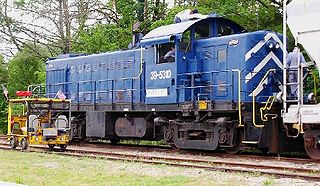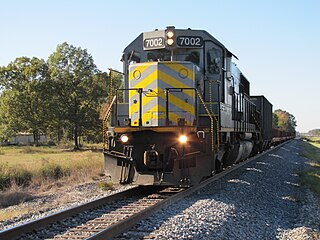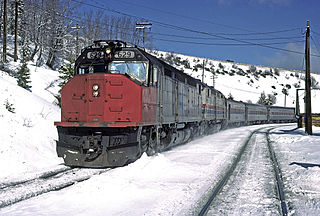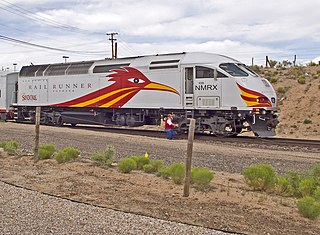
Montreal Locomotive Works (MLW) was a Canadian railway locomotive manufacturer which existed under several names from 1883 to 1985, producing both steam and diesel locomotives. For a number of years it was a subsidiary of the American Locomotive Company. MLW's headquarters and manufacturing facilities were located in Montreal, Quebec.

The EMD FP45 is a cowl unit type of C-C diesel locomotive produced in the United States by General Motors Electro-Motive Division (EMD). It was produced beginning in 1967 at the request of the Atchison, Topeka and Santa Fe Railway, which did not want its prestigious Super Chief/El Capitan and other passenger trains pulled by freight style hood unit locomotives, which have external walkways.

The EMD F40PH is a four-axle 3,000–3,200 hp (2.2–2.4 MW) B-B diesel-electric locomotive built by General Motors Electro-Motive Division in several variants from 1975 to 1992. Intended for use on Amtrak's short-haul passenger routes, it became the backbone of Amtrak's diesel fleet after the failure of the EMD SDP40F. The F40PH also found widespread use on commuter railroads in the United States and with Via Rail in Canada. Additional F40PH variants were manufactured by Morrison-Knudsen and MotivePower between 1988 and 1998, mostly rebuilt from older locomotives.

A hood unit, in North American railroad terminology, is a body style for diesel and electric locomotives where the body is less than full-width for most of its length and walkways are on the outside. In contrast, a cab unit has a full-width carbody for the length of the locomotive and walkways inside. A hood unit has sufficient visibility to be operated in both directions from a single cab. Also, the locomotive frame is the main load-bearing member, allowing the hood to be non-structural and easily opened or even removed for maintenance.

In North American railroad terminology, a cab unit is a railroad "locomotive" with its own cab and controls.

A road switcher is a type of railroad locomotive designed to both haul railcars in mainline service and shunt them in railroad yards. Both type and term are North American in origin, although similar types have been used elsewhere.

The EMD SD40-2 is a 3,000-horsepower (2,200 kW) C-C diesel-electric locomotive built by EMD from 1972 to 1989.

The SDP45 is a six-axle, C-C, 3,600-horsepower (2,680 kW) diesel-electric locomotive built by General Motors' Electro-Motive Division of La Grange, Illinois. It was a passenger-hauling version of the SD45 on a stretched locomotive frame with an extended, squared-off long hood at the rear, aft of the radiators, giving space for a steam generator for passenger train heating. This steam generator placement followed the pattern set by the SDP35 and SDP40.

The EMD Dash 2 is a line of diesel-electric locomotives introduced by General Motors' Electro-Motive Division (EMD) on January 1, 1972. Designations of these models were those of the former models with "-2" added. They retained the basic specifications of the earlier models in terms of power output and most other features, but introduced a number of improvements to the locomotives' internal systems, specifically the electrical systems and the trucks of the locomotives. These were intended to improve availability, efficiency, and ease of maintenance.

The EMD SD50 is a 3,500-horsepower (2,610 kW) diesel-electric locomotive built by General Motors Electro-Motive Division. It was introduced in May 1981 as part of EMD's "50 Series"; production ceased in January 1986. The SD50 was a transitional model between EMD's Dash 2 series which was produced throughout the 1970s and the microprocessor-equipped SD60 and SD70 locomotives. A total of 431 were built.

The EMD SD60 is a 3,800 horsepower (2,800 kW), six-axle diesel-electric locomotive built by General Motors Electro-Motive Division, intended for heavy-duty drag freight or medium-speed freight service. It was introduced in 1984, and production ran until 1995.

The EMD SD40 is an American 6-axle diesel-electric locomotive built by General Motors Electro-Motive Division between January 1966 and August 1972. 1,268 locomotives were built between 1966 and 1972. In 1972, an improved version with new electronics was developed and marketed as a new locomotive, the SD40-2.

An SDP40 is a 6-axle passenger diesel-electric locomotive built by General Motors Electro-Motive Division (EMD) between June 1966 and May 1970.

The EMD F45 is a C-C cowled diesel-electric locomotive built by General Motors Electro-Motive Division between 1968 and 1971. Power was provided by an EMD 645E3 20-cylinder engine which generated 3,600 hp (2,680 kW).

The EMD SDP40F was a six-axle 3,000 hp (2.2 MW) C-C diesel–electric locomotive built by General Motors Electro-Motive Division (EMD) from 1973–1974. Based on Santa Fe’s EMD FP45, EMD built 150 for Amtrak, the operator of most intercity passenger trains in the United States. Amtrak, a private company but funded by the United States government, had begun operation in 1971 with a fleet of aging diesel locomotives inherited from various private railroads. The SDP40F was the first diesel locomotive built new for Amtrak and for a brief time they formed the backbone of the company's long-distance fleet.

The EMD F40C is a 6-axle 3,200 horsepower (2.4 MW) diesel-electric locomotive built by General Motors Electro-Motive Division in 1974 for commuter service in Chicago. EMD only built 15 locomotives; the decline of the 6-axle design for passenger service led to the adoption of the 4-axle EMD F40PH as the standard passenger locomotive in the United States.

The passenger locomotives derivatives of the General Motors EMD GP40 diesel-electric locomotive have been, and continue to be, used by multiple passenger railroads in North America. For passenger service, the locomotives required extra components for providing steam or head-end power (HEP) for heating, lighting and electricity in passenger cars. Most of these passenger locomotives were rebuilt from older freight locomotives, while some were built as brand new models.

MPXpress is a series of diesel-electric passenger train locomotives designed for commuter rail service. The locomotives are built by MotivePower, a subsidiary of Wabtec. To date, MPI has offered five main variants: MP36PH-3S, MP36PH-3C, MP40PH-3C, MP32PH-Q, and MP54AC. However, due to federal emissions standards, the MP54AC is the only locomotive currently for sale in the United States, as it is the only MPXpress locomotive that meets Tier 4 standards.

The GE U30CG was a passenger-hauling diesel-electric locomotive built by GE Transportation Systems. It was a passenger variant of GE's U30C design purchased by the Atchison, Topeka and Santa Fe Railway. ATSF had purchased ten U28CG locomotives in 1966, but while these locomotives were satisfactory operationally, they looked like freight locomotives, not passenger locomotives. Desiring smooth-sided passenger power, the railroad ordered the first cowl units from both GE and GM-EMD. GE produced the U30CG to meet this requirement. It was identical to a U30C except that the bodywork was replaced with a full-width long hood with fluted stainless-steel panels, and a full-width rounded nose and slanted cab front were fitted.

A B unit, in railroad terminology, is a locomotive unit which does not have a control cab or crew compartment, and must therefore be operated in tandem with another coupled locomotive with a cab. The terms booster unit and cabless are also used. The concept is largely confined to North America. Elsewhere, locomotives without driving cabs are rare.























